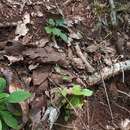Comprehensive Description
provided by North American Flora
Lobelia longicaulis Brand. Univ. Calif. Publ. Bot. 6: 73. 1914
Lobelia neglecia Vatke, Linnaea 38: 720. 1874. {Ehrenberg 520, Berlin!) Not Lobelia neglecta
R. &S. 1819. Dortmannia neglecta Kuntze, Rev. Gen. 973. 1891.
Lobelia urticifolia F. E. Wimmer, Repert. Sp. Nov. 22: 195. 1926. (Based on L. neglecia Vatke.) Lobelia poasensis F. E. Wimmer, Ann. Naturh. Mus. Wien 46: 239. 1933. (Cufodontis 605, isotype.
Field!)
Perennial, with short woody caudex and tufted fibrous or somewhat tuberous roots; stems weakly erect, decumbent or prostrate, 15-50 cm. long, often several from the same root, simple, or with few weak subordinate side branches, 1-2 (rarely 4) mm. in diameter at base, green, or purplish below, rather sparsely chaffy-pubescent, the angles somewhat winged ; cauline leaves few-20, spreading, thin or even membranous, sparsely chaffy-pubescent especially on the veins, coarsely and irregularly sharp-serrate with 2-5 teeth per cm. the blades mostly about twice as long as wide, 1-3 cm. wide by 2.5-8 cm. long or the lower smaller, ovate to broadly lanceolate or elliptic, acute or short-acuminate at tip, the base cuneate, subpetiolate or with a distinct margined petiole up to 1 cm. long; inflorescence few-35 cm. long, often occupying half the stem or more when in fruit; flowers few-25, the lower or sometimes all in the a.xils of the upper leaves, the bracts then scarcely reduced; pedicels spreading, straight or somewhat curved upward near tip, 8-30 mm. long in fruit, sparsely chaffy-pubescent (or minutely prickly, especially near distal end) or nearly glabrous; bracteoles none; flower-bracts all leafy, the upper as large as the lower or more often somewhat reduced, lanceolate to Hnear; flower 8-U mm. long, including hypanthium; corolla pale lavender (according to Skutch) or nearly white, minutely pubescent at least on the veins without, the lower lip with two green tubercles within at base, the tube 3-4 mm. long, entire except for the dorsal fissure, which extends to a point 0.7-0.3 mm. from base, the lobes of the lower lip elliptic, 1-1.5 mm. wide by 2-3.5 mm. long, the two upper lobes nearly linear, 2-3.2 mm. long; filament-tube (2.5?) 3.5—4.5 mm. long, the filaraenls pubescent at least below, connate about a third their length or a little more, adnale to the corolla-tube for about 0.7 mm.; anther-tube 1.0-1.6 mm. long, the two smaller anthers minulcly white-tufted at tip, the 3 larger ciliate on the back; hypanthium in anthesis campanulate, chaffyor prickly-pubescent or nearly glabrous, becoming ellipsoid or long-campanulate in fruit, 2.0-3.5 mm. in diameter; capsule 5.5-10 mm. long, ellipsoid, the free part 1.5-3 mm. long, one-third to two-thirds as long as the hypanlhium-tubc; calyx-lobes linear-subulate, entire, ciliate or nearly glabrous, (1.6) 3-4 mm. long; seeds ellipsoid, smooth, shining, 0.5 mm. long.
TvPB locality: Finca CovadonKa, Chiapas, Purpus 6697 (II. of Calif.!).
DiSTKiBUTiON: fcxico (state) and Michoacin to western Paiioiiia, ni<«lly at elevations of 20003000 m.
LobalU plabeU V. P.. Wimmer, Repert. Sp. Nov. 22: 194. 1926 {Liebmann pi. mex. 7772, Coi>cnagcn!) ii scarcely distinct, difTcrinx only in the linear and clonKalcd fluwcr-bracta, and in the apparently annual duration of the plants. The range is Mexico (state) to Oaxaca and Chiapas.
- bibliographic citation
- Rogers McVaugh. 1943. CAMPANULALES; CAMPANULACEAE; LOBELIOIDEAE. North American flora. vol 32A(1). New York Botanical Garden, New York, NY

